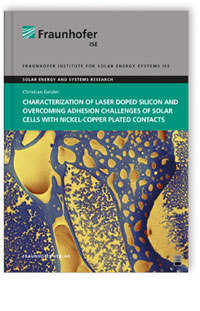
Solare Energie- und Systemforschung / Solar Energy and Systems Research
Christian Geisler
Hrsg.: Fraunhofer ISE, Freiburg/Brsg.
2015, 195 S., num., mostly col. illus. and tab., Softcover
Sprache: Englisch
Freiburg, Univ., Diss., 2015
Fraunhofer Verlag
ISBN 978-3-8396-0916-3
Inhalt
The combination of localized laser patterning and metal plating allows to replace conventional silver screen printing with nickel-copper plating to form inexpensive front contacts for crystalline silicon solar cells. In this work, a focus is put on effects that could cause inhomogeneous metal deposition and low metal contact adhesion. A descriptive model of the silicon nitride ablation mechanism is derived from SEM imaging and a precise recombination analysis using QSSPC measurements. Surface sensitive XPS measurements are conducted to prove the existence of a parasitic surface layer, identified as SiOxNy. The dense SiOxNy layer is an effective diffusion barrier, hindering the formation of a nickel silicide interlayer. After removal of the SiOxNy layer, cells show severe degradation caused by metal-induced shunting. These shunts are imaged using reverse biased electroluminescence imaging. A shunting mechanism is proposed and experimentally verified. New laser process sequences are devised and proven to produce cells with adhering Ni-Cu contacts. Conclusively the developed processes are assessed based on their industrial feasibility as well as on their efficiency potential.
Verfügbare Formate
* Alle Preise verstehen sich inkl. der gesetzlichen MwSt. Lieferung deutschlandweit und nach Österreich versandkostenfrei. Informationen über die Versandkosten ins Ausland finden Sie hier.

